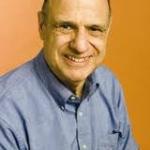This kind of thing is ego doing its most basic job. Unfortunately, ego likes to extend its portfolio. Its memory function, for example, can grab onto bad experiences and turn them into a negative feed-back loop, so that past wounds and painful memories get lodged in your cells and become crippling blocks in your body and brain. That's part of the downside of the second aspect of ego, ego as False Identification.
This—in the yoga tradition it's called asmita -- is the ego with the bad rap. Asmita is the little gremlin that grabs onto every thought, opinion, feeling, and action that swims into consciousness and identifies it as 'me' and 'mine.' Years ago, near Santa Cruz, California, a member of the old Hell's Angels motorcycle gang started a fight with a tourist that turned into a melee. Asked what had happened to trigger his wrath, the Angel declared, "He touched my bike. Man, you touch my bike, you touch me." This may seem like an over-the-top example of what the yogic texts call "identifying the self with its limiting adjuncts," but it's not actually so different from what we so-called rational people do. You may not be identified with your bike, or your car, but you certainly identify with your own thoughts and opinions and feelings, not to mention the your job description and your various social roles. Your ego may be invested in your social skills, your coolness, or, like Cindy, in your ability to perform in the daily office shoot-out. As long as that's the case, you're bound to go up and down with the tides of the day, literally bounced around by who you think you are.
It's this tendency to identify with our thoughts and feelings about ourselves and the world that creates the problem of ego. If we were able to let thoughts and feelings pass through us, or if we could identify with our bodies purely functionally, we wouldn't waste hours worrying about the shape of our thighs. We wouldn't get insulted, or nurse our hurt feelings, or worry about whether or not we are smart enough or worthy enough or strong enough. In short, we wouldn't spend our days riding the emotional seesaw that forms the backdrop of most people's days.
One of the best antidotes to this tendency is to practice expanding your sense of self by including others in your personal territory. Many of the best yogic and Buddhist attitudinal practices—like wishing for others' happiness, or the powerful practice of tonglen, giving and receiving, in which you breathe in the pain of others and breathe back to them happiness and good fortune—are really techniques for expanding the circle of selfhood. During the aftermath of Japan's earthquake, some friends and I sat together, visualized the scenes of devastation we were seeing on TV, and then breathed in with the feeling that we were taking in the fear and discomfort, the hunger and despair of the people who had lost everything. On the exhalation, we'd imagine light and warmth flowing from us to them. Whether or not this practice affected the tsunami victims, it had a powerful effect on our own hearts. The sense of being isolated, protected, separate from the people huddled in their makeshift shelters would give way to a sense of shared consciousness, and we would feel how deeply linked each human soul is to all other souls. The practice can literally melt—at least temporarily—the contraction of feeling separate from others. And this is the beginning of freedom from the isolation and fear that ego fosters.
My Guru, Swami Muktananda, used to say that our real problem with ego is that it isn't big enough. He'd say that we identify with our apparent self, our small self—the self defined by our bodies and minds—when what we should really identify with is the pure Awareness, power, and love that lives at the heart of everything. As far as he was concerned, there was no point in trying to get rid of ego. Instead, he taught us to enlarge the way we identified it—in other words, to identify with the All, with pure Spirit, instead of with the particular.
A truly healthy ego, in his terms, would be one that comfortably did its job of creating necessary boundaries and keeping us functioning as individuals on the earth plane. But rather than seeing itself as bounded by the personality, or identifying with its thoughts and opinions, this ego would know the real secret: that the 'me' who calls itself Jane or Charlie is just the tip of the iceberg of something loving and free that is living as 'me': Spirit itself—the Presence at the heart of everything . . . and, simultaneously, nothing at all. In other words, that ego wouldn't get caught up in attaching its identity to small gains and losses. It would know, like Walt Whitman, that we contain multitudes.
Yet getting from here to there—from identifying yourself as Jane to identifying yourself as pure Presence and love—is a tall order. So the traditions offer a middle step: the practice and the experience of the ego as pure 'I am,' not 'I am somebody' or 'I am tired' or 'I am angry,' but a pure 'I am' without the accompanying self-definition. The bridge between the limited ego and the expanded, world-identified I-sense, is the recognition that behind everything we attach to our ego is a simple awareness.





